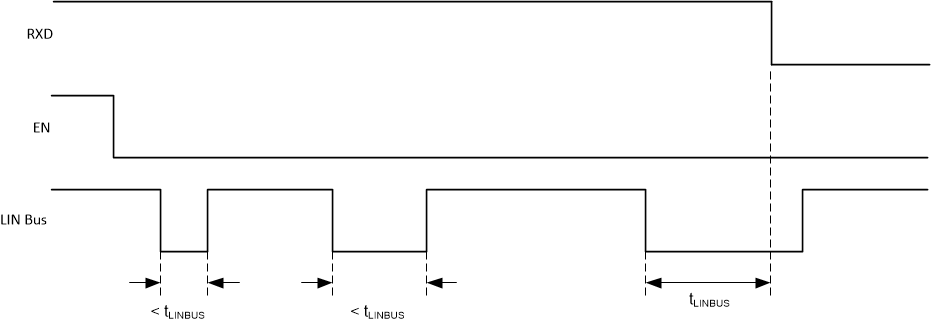SLLSFG0B November 2019 – May 2022 TLIN1028S-Q1
PRODUCTION DATA
- 1 Features
- 2 Applications
- 3 Description
- 4 Revision History
- 5 Description (continued)
- 6 Pin Configuration and Functions
- 7 Specification
- 8 Parameter Measurement Information
-
9 Detailed Description
- 9.1 Overview
- 9.2 Functional Block Diagram
- 9.3 Feature Description
- 9.4 Device Functional Modes
- 10Application and Implementation
- 11Power Supply Recommendations
- 12Layout
- 13Device and Documentation Support
- 14Mechanical, Packaging, and Orderable Information
Package Options
Mechanical Data (Package|Pins)
- D|8
Thermal pad, mechanical data (Package|Pins)
Orderable Information
9.3.9.2 Bus Stuck Dominant System Fault: False Wake Up Lockout
The device contains logic to detect bus stuck dominant system faults and prevents the device from waking up falsely during the system fault. Upon entering sleep mode, the device detects the state of the LIN bus. If the bus is dominant, the wake-up logic is locked out until a valid recessive on the bus “clears” the bus stuck dominant, preventing excessive current use. Figure 9-3 and Figure 9-4 show the behavior of this protection.
 Figure 9-3 No Bus Fault: Entering Sleep Mode with Bus Recessive Condition and Wakeup
Figure 9-3 No Bus Fault: Entering Sleep Mode with Bus Recessive Condition and Wakeup Figure 9-4 Bus Fault: Entering Sleep Mode with Bus Stuck Dominant Fault, Clearing, and Wakeup
Figure 9-4 Bus Fault: Entering Sleep Mode with Bus Stuck Dominant Fault, Clearing, and Wakeup